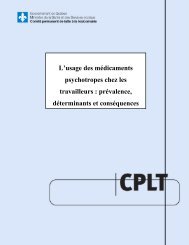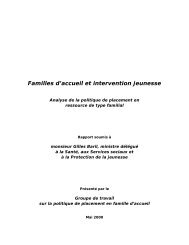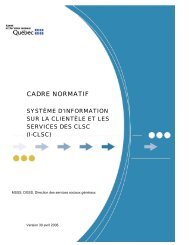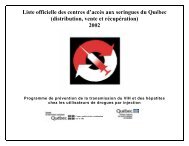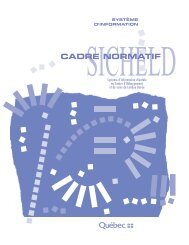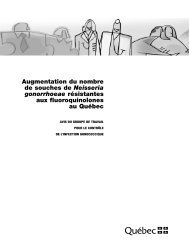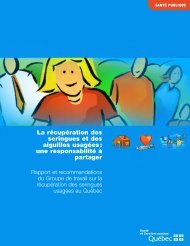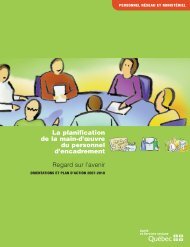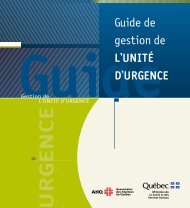De l'innovation au changement - Gouvernement du Québec
De l'innovation au changement - Gouvernement du Québec
De l'innovation au changement - Gouvernement du Québec
Create successful ePaper yourself
Turn your PDF publications into a flip-book with our unique Google optimized e-Paper software.
Projet 40<br />
Élaboration d’outils de dépistage et d'évaluation <strong>au</strong>près des aidantes<br />
process, leading us to conclude that efforts need to be made to organise their intake proce<strong>du</strong>res in a such way that caregivers can be<br />
screened for risk since this would better target interventions; 3) the tool standardises and objectives screened appreciation of caregiver<br />
situations and targets caregivers at risk; 4) the tool works for a variety of caregiver situations.<br />
Asssessment tool :<br />
The results of the inter-rater reliability and internal consistency tests suggest that, for the most part, this comprehensive tool is a valid and<br />
reliable instrument to understand caregivers’ needs and situations.<br />
The assessment tool was able to both achieve its functional aims of identifying key concerns and at the same time had a positive impact o<br />
assessors and caregivers. The tool changed assessors’ attitudes, and occasionally their practice with caregivers, while for caregivers, a<br />
noted by both assessors and administrators, the tool gave them recognition and validated their concerns and everyday efforts.<br />
According to assessors, the research process resulted in an increased understanding/awareness of the concrete reality of what it means to<br />
be a caregiver on a daily basis. Repeatedly throughout the research sites, workers discussed their shock or surprise upon discovering the<br />
widespread difficulties faced by caregivers and that for many caregiving was not a choice. In this sense, the project gave workers access to<br />
the meanings and everyday realities behind the facts of caregiving and gave them a different perspective on caregiver concerns. Workers<br />
indicated that probably over time they would get similar information, but it would take them much longer to do so. However, this<br />
appreciation is mitigated by the fact that many assessors found the tool to be very long and the average evaluation took 90 minutes, as<br />
noted in their written comments.<br />
Thus, despite the one site which had difficulty adjusting to the tool, we can conclude that, in general, the assessment tool has great<br />
potential for improving the quality of services to caregivers, and indirectly, to care recipients.<br />
It was evident through discussions with assessors and administrators that participation in this research project had several impacts on<br />
practice and raised, in a dramatic way, the current lack of access caregivers have to evaluations and services. The assessment tool aided<br />
caregivers, practitioners and administrators alike to identify the quasi-absence of resources aimed at modifying caregivers’ situations and<br />
those services and resources which would be essential to develop to meet the needs of caregivers.<br />
1.1.3.1 The first way the tool is relevant to agency practice is that it legitimises giving time to caregivers to hear their stories.<br />
This is relevant bec<strong>au</strong>se it provides room for a new perspective within service provision and the larger context of policies related<br />
to families, and it legitimises caregivers to identify their own needs as distinct from those of the person they are caring for.<br />
Indeed of the 168 caregivers assessed, 60% reported that this was the first opportunity they had to discuss their situation and their<br />
comments suggest that it was meaningful experience for them.<br />
1.1.3.2 Going through the process of assessing and documenting caregiver issues helped workers to understand why the<br />
caregiver is burnt out, determine appropriate services and provide a rationale for intervention.<br />
There were several unanticipated positive outcomes of the project. First, we were surpised to what extent participating practitioners and<br />
supervisors felt their participation was perceived as a form of training. Many spoke of how they had been privileged to be part of the project<br />
bec<strong>au</strong>se they are now better trained on caregiver issues. Second, we had not forseen the impact the assessment tool would have on<br />
current practice given the research nature of the project and the stipulation that information gathered <strong>du</strong>ring this process should not impact<br />
on service delivery. However, the testing of the assessment tool enabled a majority of participating practitioners to identify problematic<br />
situations which required immediate intervention but which otherwise might have gone unrecognised. Finally, we were unprepared for the<br />
overwhelming interest shown by the majority of agencies and researchers contacted <strong>du</strong>ring Phase I and which continued throughout the<br />
life of the project.<br />
205





